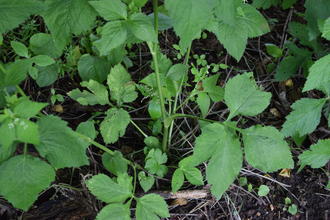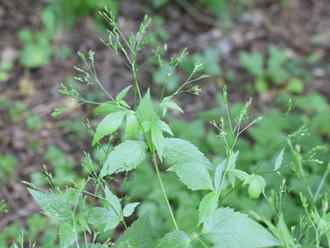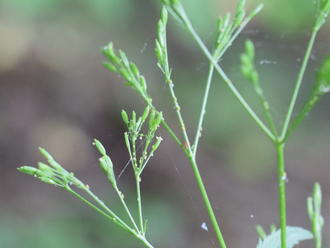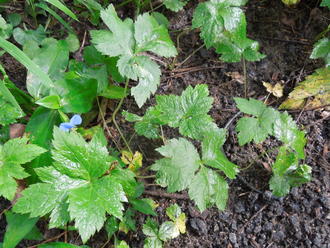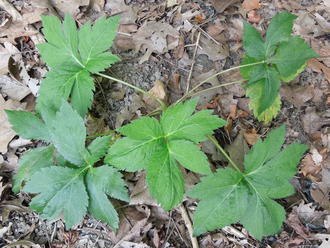Honewort (Cryptotaenia canadensis (L.) DC.)
↑Summary
An herbaceous perennial plant native to eastern North America, common in riparian areas and moist woodlands.
↑Range - Expand
| Legend | Color |
| Native | |
| Native or Not Present | |
| Extirpated |
This tentative map is based on our own research. It may have limited data on Canada and/or Mexico, and there is some subjectivity in our assignment of plants as introduced vs. expanded. Read more in this blog post.
Although this plant occurs somewhere in each of these regions, it may only occur in a small part of some or all of them.
↑Description & Identification
Honewort is characterized by trifoliate compound leaves that are irregularly doubly serrated, and often deeply cut. Different individual plants or even leaves on the same plant can look quite different.
↑Similar Plants
↑Habitat
Found in woodlands. Especially common in floodplains and moist bottomlands, but occasionally on richer upland sites as well. Also found in moist, shaded parts of gardens and suburban areas. Found both in intact natural areas and disturbed or anthropogenic habitats. Often most abundant in riparian areas, growing directly adjacent to water, where it forms large colonies. On drier, upland sites, usually only found as isolated plants.
Prefers medium to light shade, moist to mesic conditions, and rich, loamy soil with ample organic matter. Also often grows in silty soils. Tolerates waterlogged soils and temporary flooding.
↑Life Cycle
Honewort is an herbaceous perennial that is sometimes classified as a biennial; it has a somewhat flexible lifecycle enabling it to adapt to a wide range of conditions. Plants survive as perennials by reproducing vegetatively at the base, forming small colonies of ramets (clonal individuals), with the older plant dying after setting seed. Very rarely, plants will live as annuals.
Especially in shade, first-year plants rarely flower and may only grow an inch or a few inches tall. Under more favorable conditions, first-year plants can flower and produce seed, but usually not as profusely as established plants.
Second-year plants grow substantially taller and produce larger leaves, followed by flowers in late spring to early summer. Seeds mature in late summer. Rarely, particularly when heavily shaded, plants may take longer than 2 years to flower. Usually around May, about when flowers are starting to form, vegetative buds also start forming underground, forming new ramets. New leaves from these ramets start emerging in late August through early September; many ramets tend to function as winter annuals, growing through fall, overwintering, and dying after making seeds in the next summer.
Seeds are heavy and typically fall close to the parent plant. The heavy seed, coupled with this plant's preference for low-lying, flat areas, can cause it to form dense colonies while only spreading slowly and occasionally into more distant sites. Seeds require cold stratification, and germinate mostly in spring (March-April), but occasionally later in the growing season in response to disturbance. Most seeds germinate in the first year, but some seeds germinate in subsequent years, with a few germinating as late as the fourth spring following seedfall. This species thus forms a short-term seed bank.
In mild winters, the basal leaves will sometimes persist through winter, especially on sheltered sites.
In dry conditions, the leaves will wither and often all above-ground parts of the plant will die. Plants often resprout in the same season after the end of a short but intense drought, or will be replaced in subsequent years with seedlings if the plants are killed after a more prolonged drought.
Although this plant usually blooms early-to-mid-summer, bloom time is somewhat flexible and will occur later under certain conditions.
↑Faunal Associations
This foliage is browsed by deer and other mammalian herbivores. Dense colonies in rich bottomlands provide valuable cover for a variety of animals.
The small flowers attract a variety of small bees, wasps, flies, and beetles.
This plant is a host of the larvae of the eastern black swallowtail butterfly (Papilio polyxenes), and the Agonopterix clemensella moth, both of which eat various plants in this family, as well as the leaf-miner moth Epermenia pimpinella, which is more specialized on this genus along with the closely-related Zizia and Taenidia genera.
The sap is eaten by aphids, including the willow-carrot aphid (Cavariella aegopodii) and the fennel aphid Hyadaphis foeniculi, both of which also eat other plants in this family. The leaves are mined by the larvae of the celery fly (Euleia heraclei).
↑Uses
All parts of this plant are edible; however, plants of this family can be hard to identify, and this family contains some very poisonous plants, so exercise caution.
Western society does not utilize this plant as a food, although some inspiration can be taken from the Japanese use of the closely related Cryptotaenia japonica, whose spring-harvested leaves are often added to soups.
This plant is visually similar to bishop's goutweed (Aegopodium podagraria), a plant that is widely planted as a groundcover, but is considered invasive in North America. As Honewort grows well in similar conditions, it can be used as a native substitute for that groundcover.
↑Related Plants
Cryptotaenia japonica, known in Japanese as mitsuba, is a close relative, and is cultivated as a food plant in Japanese and Korean cultures. It has been introduced to North America both as a food plant, and an ornamental (a red-leafed cultivar.) The red-leaf cultivar is sometimes found in the wild. C. japonica can be distinguished from its larger flowers, and smaller number of flowers per flowerhead.
↑Links & External Resources
• Cryptotaenia canadensis (Honewort) | Illinois Wildflowers (About This Site)
• Cryptotaenia canadensis (Honewort) | USDA PLANTS Database (About This Site)
• Cryptotaenia canadensis | Go Botany (About This Site)
• Honewort | iNaturalist (About This Site)
• Cryptotaenia canadensis (Canadian Honewort) | Missouri Botanical Garden Plant Finder (About This Site)
• Cryptotaenia canadensis | Biota of North America Project (BONAP) (About This Site)
• Cryptotaenia canadensis | NatureServe Explorer (About This Site)
• Cryptotaenia canadensis | Missouri Plants (About This Site)
• Canadian Honewort | Maryland Biodiversity Project (About This Site)
• Cryptotaenia canadensis (Canadian Honewort) | Minnesota Wildflowers (About This Site)
• Cryptotaenia canadensis (L.) DC. (Honewort) | Digital Atlas of the Virginia Flora (About This Site)






